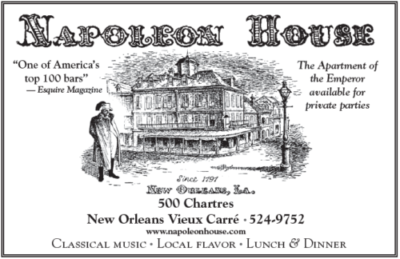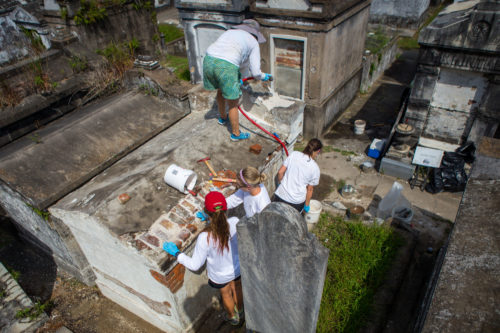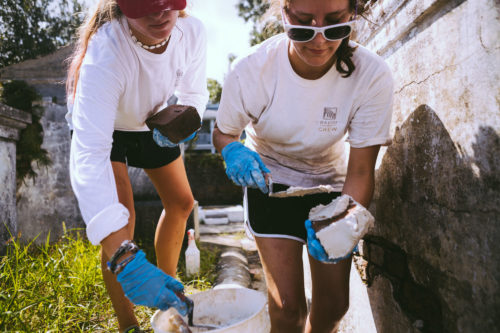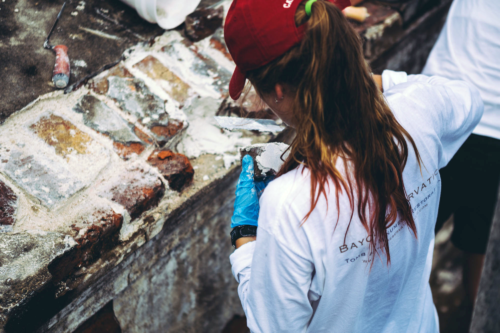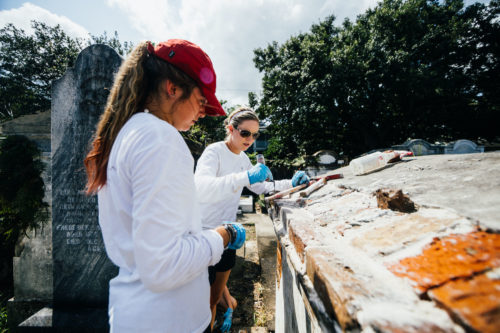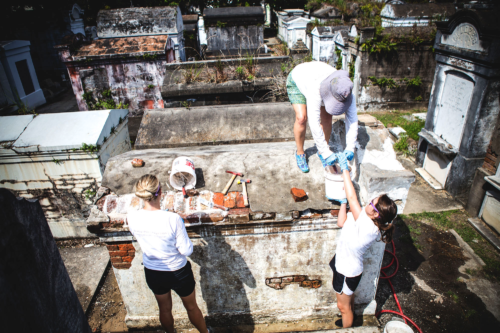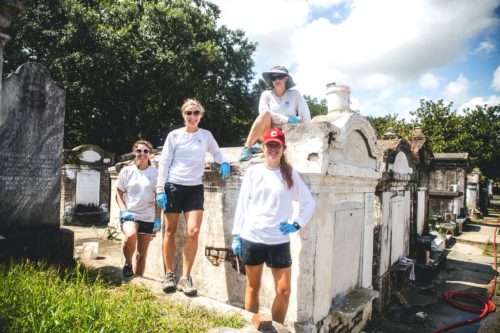This story first appeared in the October issue of the PRC’s Preservation in Print magazine. Interested in getting more preservation stories like this delivered to your door each month? Become a member of the PRC for a subscription!
Architectural conservator Michelle Stanard Duhon with Bayou Preservation remembers working with her staff to restore a tomb at the historic and tightly packed Lafayette Cemetery No. 1. A section in the tomb’s slate ceiling had caved in, enticing passersby to stop, gawk and attempt to take pictures of the coffin, which was visible through a hole in the roof.
The Bayou Preservation team shooed away the photo-snapping sightseers, then asked the city to move the remains from the top vault to the caveau, or bottom of the tomb, so the restoration work could be completed.
The repair project was successful, but the incident reflects how challenging maintaining a grave in one of New Orleans’ world-famous cemeteries can be. Holes, crumbled granite and bruised marble all make cleaning and performing upkeep on graves a tricky proposition, particularly for family members who may not have professional restoration expertise.
In the vast majority of cases, it’s largely up to the family or plot owner to provide maintenance, said Juliette Hotard, restoration and volunteer coordinator for Save Our Cemeteries. At city-owned cemeteries, the administration isn’t responsible for upkeep. At privately owned cemeteries, plot owners can pay for a “perpetual care” plan. Without it, the owner is responsible for maintenance.
Duhon, Hotard and other preservation experts have advice for loved ones interested in refurbishing a family tomb. Their overall message: be gentle.
Advertisement
Here are their key tips:
- Don’t pressure wash. Instead, use soft-bristled brushes and mild dish soap on non-stone surfaces. (Duhon personally recommends Dawn soap.) Dilute the sudsy stuff well and “rinse, rinse, rinse,” Duhon said. A product called D/2 Biological Cleaner also is popular, but it can be pricey.
- Avoid weed killers like Roundup, which stain the stone.
- Avoid bleach, especially on marble, which is particularly vulnerable to the caustic chemical.
- A yearly limewash is highly recommended, Duhon said. After cleaning the tomb, apply new limewash over existing limewash and exposed plaster or stucco. Limewash cannot be applied over paint. Pre-made limewash can be purchased online.
- Avoid using Portland cement for repairs or slathering on latex paint.
Try for a thorough cleaning once a year, and then do periodic inspections to make sure everything is copacetic, Hotard and Duhon agreed. If you find cracks, breaks or stains on the marble, reach out to a preservation expert. In severe cases, permits might be required for repairs, a process that can be helped along by experts.
Hotard recommends the National Park Service’s Historic Preservation Standards and Guidelines for further advice, adding that if tombs or copings are seriously damaged, contact a tomb restoration professional. Finally, she said Save Our Cemeteries and other community groups do their best to maintain graves that have been abandoned or for which the family line has died out.
“If family tombs and copings are cared for regularly, it is not difficult to keep them in shipshape,” Hotard said. “There are many tombs in New Orleans that have been around for a hundred or more years. It is when tombs and copings are neglected that they begin to rapidly decline.”
Advertisements





